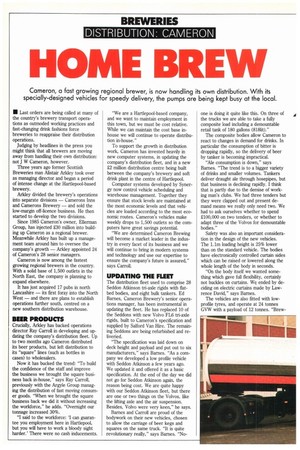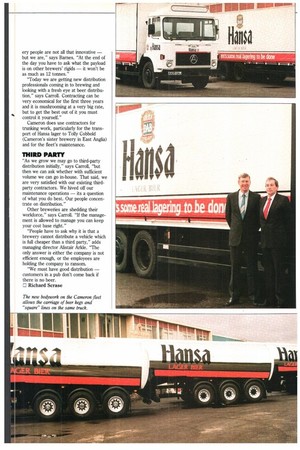HOM BREW
Page 48

Page 49

If you've noticed an error in this article please click here to report it so we can fix it.
Cameron, a fast growing regional brewer, is now handling its own distribution. With its specially-designed vehicles for speedy delivery, the pumps are being kept busy at the local.
• Last orders are being called at many of the country's brewery transport operations as outmoded working practices and fast-changing drink fashions force breweries to reappraise their distribution operations.
Judging by headlines in the press you might think that all brewers are moving away from handling their own distribution: not J. W Cameron, however.
Three years ago former Scottish Breweries man Alistair Arkley took over as managing director and began a period of intense change at the Hartlepool-based brewery.
Arkley divided the brewery's operations into separate divisions — Camerons Inns and Camerons Brewery — and sold the low-margin off-licence business. He then started to develop the two divisions.
Since 1985 Cameron's owner, Ellerman Group, has injected 230 million into building up Cameron as a regional brewer. Meanwhile Arldey has built up a management team around him to oversee the company's growth — Arkley appointed 24 of Cameron's 28 senior managers.
Cameron is now among the fastest growing regional brewers in the country. With a solid base of 1,500 outlets in the North East, the company is planning to expand elsewhere.
It has just acquired 17 pubs in north Lancashire — its first foray into the North West — and there are plans to establish operations further south, centred on a new southern distribution warehouse.
BEER PRODUCTS
Crucially, Arkley has backed operations director Ray Carroll in developing and updating the company's distribution fleet. Up to two months ago Cameron distributed its beer products, but left distribution to its "square" lines (such as bottles in cases) to wholesalers.
Now it has bucked the trend: "To build the confidence of the staff and improve the business we brought the square business back in-house," says Ray Carroll, previously with the Argyle Group managing the distribution of fast moving consumer goods. "When we brought the square business back we did it without increasing the workforce," he adds. "Overnight our tonnage increased 30%.
"I said to the workforce: 'I can guarantee you employment here in Hartlepool, but you will have to work a bloody sight harder.' There were no cash inducements. "We are a Hartlepool-based company, and we want to maintain employment in this town, but we must be cost relative. While we can maintain the cost base inhouse we will continue to operate distribution in-house."
To support the growth in distribution work, Cameron has invested heavily in new computer systems, in updating the company's distribution fleet, and in a new 22 million distribution centre being built between the company's brewery and soft drink plant in the centre of Hartlepool.
Computer systems developed by Synergy now control vehicle scheduling and warehouse management. Together they ensure that stock levels are maintained at the most economic levels and that vehides are loaded according to the most economic routes. Cameron's vehicles make weekly drops to 1,500 outlets so the computers have great savings potential.
"We are determined Cameron Brewing will become a market leader in the industry in every facet of its business and we will continue to bring in modern systems and technology and use our expertise to ensure the company's future is assured," says Carroll.
UPDATING THE FLEET
The distribution fleet used to comprise 28 Seddon Atkinson tri-axle rigids with flatbed bodies, and eight bulk tankers. Ed Barnes, Cameron Brewery's senior operations manager, has been instrumental in updating the fleet. He has replaced 10 of the Seddons with new Volvo FL6 tri-axle rigids, built to Cameron's specification and supplied by Salford Van Hire. The remaining Seddons are being refurbished and reliveried.
"The specification was laid down on deck height and payload and put out to six manufacturers," say S Barnes. "As a company we developed a low profile vehicle with Seddon Atkinson a few years ago. We updated it and offered it as a basic specification. At the end of the day we did not go for Seddon Atkinson again, the reason being cost. We are quite happy with our Seddon Atkinson fleet, but there are one or two things on the Volvos, like the lifting axle and the air suspension. Besides, Volvo were very keen," he says.
Barnes and Carroll are proud of the bodywork on their new vehicles, chosen to allow the carriage of beer kegs and squares on the same truck. "It is quite revolutionary really," says Barnes. "No
one is doing it quite like this. On three of the trucks we are able to take a fully composite load including a demountable retail tank of 180 gallons (8181it)."
The composite bodies allow Cameron to react to changes in demand for drinks. In particular the consumption of bitter is dropping rapidly, so the delivery of beer by tanker is becoming impractical.
"Ale consumption is down," says Barnes. "The trend is to a bigger variety of drinks and smaller volumes. Tankers deliver draught ale through hosepipes, but that business is declining rapidly. I think that is partly due to the demise of working man's clubs. We had three tenders but they were clapped out and present demand means we really only need two. We had to ask ourselves whether to spend 2100,000 on two tenders, or whether to adapt three of the Volvos for demountable bodies."
Safety was also an important consideration in the design of the new vehicles. The 1.1m loading height is 25% lower than on the standard vehicle. The bodies have electronically controlled curtain sides which can be raised or lowered along the whole length of the body in seconds.
"On the body itself we wanted something which gave full flexibility, certainly not buckles on curtains. We ended by deciding on electric curtains made by Lawrence David," says Barnes.
The vehicles are also fitted with lowprofile tyres, and operate at 24 tonnes GVW with a payload of 12 tonnes. "Brew ery people are not all that innovative — but we are," says Barnes. "At the end of the day you have to ask what the payload is on other brewers' rigids — it won't be as much as 12 tonnes."
"Today we are getting new distribution professionals coming in to brewing and looking with a fresh eye at beer distribution," says Carroll. Contracting can be very economical for the first three years and it is mushrooming at a very big rate, but to get the best out of it you must control it yourself."
Cameron does use contractors for trunking work, particularly for the transport of Hansa lager to Tolly Cobbold (Cameron's sister brewery in East Anglia) and for the fleet's maintenance.
THIRD PARTY
"As we grow we may go to third-party distribution initially," says Carroll, "but then we can ask whether with sufficient volume we can go in-house. That said, we are very satisfied with our existing thirdparty contractors. We hived off our maintenance operations — its a question of what you do best. Our people concentrate on distribution."
Other breweries are shedding their workforce," says Carroll. "If the management is allowed to manage you can keep your cost base right."
"People have to ask why it is that a brewery cannot distribute a vehicle which is full cheaper than a third party," adds managing director Alistair Arkle. "The only answer is either the company is not efficient enough, or the employees are holding the company to ransom.
"We must have good distribution — customers in a pub don't come back if there is no beer.
LI' Richard Scrase




































































































































